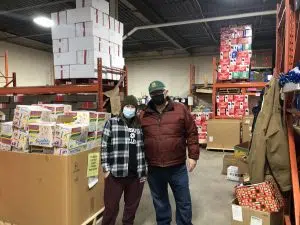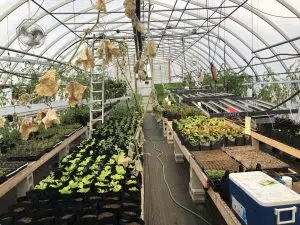
The warehouse where everything is organized. Don’t get too excited about the beer boxes though. All the boxes are donated by Labatt’s and are used for storage (Connor Luczka/ XFM News).
News recently broke that Ontario Food Banks have seen a 10% increase in the last year. London’s Food Bank has seen that too.
Jane Roy is the co-executive director of the Food Bank. She says that while its hard to judge usage of the Bank in such broad terms– since it’s always going up and down– they have seen a huge increase in the recent year.
“When you look at the last six months over last year’s period– it’s a 21% increase . . . With November we’ve seen another 10% increase. We served almost 3600 families that month and that’s the second busiest we’ve ever been in the Food Bank.”
Chantell Carreiro is a volunteer supervisor at the Food Bank. She says that on the ground level there was a noticeable uptick. More and more people were coming to the Food Bank and their 5 satellite sites around the city.
London’s Food Bank has the least amount of staff than any other Food Bank of its size. Food Banks of Waterloo or Kitchener have about 20 staff on hand. In London, they have 6 full-time staff and 2 part-time staff. They manage to run such a tight ship through the strength of their volunteers. Luckily, Carreiro says that because so many people were off work during the pandemic, they managed to get more volunteers during the pandemic to help alleviate the huge demand.
Roy says the usage increase during the pandemic is not surprising– for a number of reasons. One being a squeeze on other institutions other than the Food Bank.
“Not all of the social agencies are doing the things that they were doing before the pandemic hit. For instance, a lot of churches aren’t running programs. There used to be a lot of places where people could go for meals, leftover and hamper programs, and a lot of those haven’t started up yet.”
Without these other programs, more people have had to rely on the Food Bank, which was categorized as an essential service. It won’t get any easier with the holidays around the corner either. Every year there is always a need. Every year is the same story, but that’s the nature of the Food Bank.
“When you think about the Food Bank and the people that we help, it’s not always the same person. A lot of people come over once a year or a couple times during the year. We become kind of the canary in the coal mine. That when things become tough, the first part of your budget that really gets hit is your food.”
“Things are going to continue to be really, really tough for a lot of folks. And there’s more and more new folks whose rents and hydro continue to go up and because of that, they’ll end up coming to the Food Bank for help.”
The Food Bank’s Facility

Volunteers Chantell Carreiro (left) and Sandy Burke (right), standing in the warehouse (Connor Luczka/ XFM news).
Just off of Leathorne St., around the corner from Adelaide and Commissioners, the Food Bank’s main facility is a huge warehouse in the middle of an industrial zone.
Carreiro went through their facility and showed just how in need the Food Bank is– and the extent to which they stretch donations.
Donations come in through many different avenues. Every week volunteers go to every single grocery store in the city to retrieve donations. Through the generosity of the Refresh program and other grocery stores, they have a steady stream of perishables and non-perishables coming in.
Every donation is opened so that they can give out to more families. For instance, milk bags are separated and given to families based on size. Single person households are given one bag while 5+ households get a full 3.
Don’t worry about any waste. They reuse every container or bag they get and recycle any waste. Any perishable that expires also gets reused.

Even though its a cold autumn day with snow outside, the plants are kept at the right temperature year round (Connor Luczka/ XFM News).
The Food Bank recently opened up a new greenhouse and composting system. Anything that gets expired gets reclaimed through composting and more produce is grown.
They are also working on small plant-pouches that can grow in apartments, so that users can grow their own herbs there.
Jane Roy says that when thinking of what to donate think about your own habits.
“Buy the things that you yourself use and eat. So when it comes to non perishable, it’s the typical things. It’s everything from the cereals to the soups to the canned vegetables. Canned tuna is really important. But we also take perishables– as in produce.”
Produce is a big need. Also in need are feminine hygiene products. Carreiro says that even though there are programs that donate, that is still an area with a huge deficit of donations.
Business Cares Food Drive
On December 1st, the Business Cares Food Drive got underway. This is the 22nd year its been running and Roy says it is essential to how they operate.
“There was a lot of fun between the Construction Association and the Home Builders’ Association challenging each other . . . We’ve been doing Business Cares for over a couple decades so it’s always the yin and the yang for us. It’s still really tough that so many people are needing help. But the opposite is that so many Londoners are wanting to be part of the solution . . . I always find it uplifting when I see the number of folks and the number of businesses getting together to make a difference.”
As this year gets busier and busier for the Food Bank, the Business Cares Food Drive is hoping they can help, even during such a difficult time.





Comments